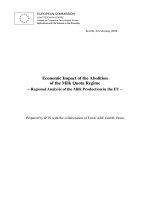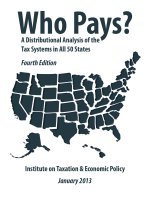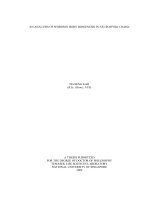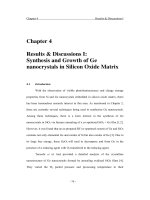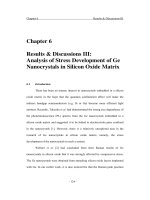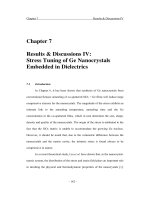Analysis of martin harrington theorem in higher order arithmetic
Bạn đang xem bản rút gọn của tài liệu. Xem và tải ngay bản đầy đủ của tài liệu tại đây (859.94 KB, 134 trang )
ANALYSIS OF MARTIN-HARRINGTON
THEOREM IN HIGHER ORDER
ARITHMETIC
CHENG YONG
(MASTER IN PHILOSOPHY, PEKING UNIVERSITY)
A THESIS SUBMITTED
FOR THE DEGREE OF DOCTOR OF PHILOSOPHY
DEPARTMENT OF MATHEMATICS
NATIONAL UNIVERSITY OF SINGAPORE
2012
i
DECLARATION
I hereby declare that this thesis is my original work and it has been writ-
ten by me in its entirety.
I have duly acknowledged all the sources of information which have been
used in the thesis.
This thesis has also not been submitted for any degree in any university
previously.
Date: 28 July 2012
ii
Acknowledgements
Firstly, it is a pleasure to express my gratitude here to my co-supervisor
Professor W.Hugh Woodin for his capable guidance on my writing of this
thesis. This thesis is a joint work with Professor W.Hugh Woodin. Firstly,
I thank Professor W.Hugh Woodin for introducing me thesis problems dis-
cussed in this thesis. Secondly, I thank him for his patience and generosity,
for his willingness to share his time, insight and knowledge, for his support
and help in the past years and for his enthusiasm to answer my questions
on set theory. Thirdly, I thank him for his careful examination of the first
version of this thesis and providing corrections and suggestions for improve-
ments. Especially, I thank Professor W.Hugh Woodin for his time spent on
discussions with me about the thesis.
I would also like to thank my NUS supervisor Professor Chong Chi Tat
for his support of my study at NUS. I have taken nine modules during my
four-year study at NUS: two modules on analysis by Professor Xu Xingwang
and Chua Seng Kee, two modules on algebra by Professor A.J.Berrick, three
modules titled “recursion theory” and “logic and foundation of mathematics
I and II” by Professor Yang Yue, one module titled “model theory” by Pro-
iii
fessor Yu Liang and a graduate seminar module by Professor Frank Stephan.
Thank the professors of all these modules I have taken. I would also like to
thank my thesis examiners for their careful examination of my first submit-
ted version of the thesis, for pointing out some errors and for providing some
corrections and suggestions for improvements. Also I would like to thank the
NUS mathematics department for financial support of my graduate studies.
Contents
1 Introduction 1
1.1 Notations and definitions . . . . . . . . . . . . . . . . . . . . . 1
1.2 Thesis Problems . . . . . . . . . . . . . . . . . . . . . . . . . . 17
1.3 The structure of the thesis . . . . . . . . . . . . . . . . . . . . 20
2 Minimal system for “Harrington’s implies 0
exists” in high-
er order arithmetic 21
2.1 Forcing background . . . . . . . . . . . . . . . . . . . . . . . . 24
2.1.1 Almost disjoint forcing . . . . . . . . . . . . . . . . . . 24
2.1.2 Some notions of forcing . . . . . . . . . . . . . . . . . . 27
2.2 Z
2
+ Harrington’s does not imply 0
exists . . . . . . . . . 33
2.3 Z
3
+ Harrington’s does not imply 0
exists . . . . . . . . . 41
2.3.1 Weakly reflecting property and strong reflecting property 41
2.3.2 Baumgartner’s forcing . . . . . . . . . . . . . . . . . . 59
2.3.3 The structure of the proof . . . . . . . . . . . . . . . . 68
2.3.4 Step One . . . . . . . . . . . . . . . . . . . . . . . . . 71
iv
CONTENTS v
2.3.5 Step Two . . . . . . . . . . . . . . . . . . . . . . . . . 76
2.3.6 Step Three . . . . . . . . . . . . . . . . . . . . . . . . 80
2.3.7 Step Four . . . . . . . . . . . . . . . . . . . . . . . . . 87
2.3.8 Step Five . . . . . . . . . . . . . . . . . . . . . . . . . 99
3 Proof of Harrington’s theorem 110
3.1 Boldface Harrington’s theorem in Z
2
. . . . . . . . . . . . . . 110
3.2 W.Hugh Woodin’s proof of Harrington’s theorem . . . . . . . 112
4 Conclusions 122
CONTENTS vi
Summary
The main effort in this thesis is to answer some questions from Professor
W.Hugh Woodin about Martin-Harrington theorem. The boldface Martin-
Harrington theorem says that Det(Σ
1
1
∼
) if and only if for any real x, x
exists
and the lightface Martin-Harrington theorem says that Det(Σ
1
1
) if and only
if 0
exists.
Harrington’s theorem “Det(Σ
1
1
) implies 0
exists” is proved in two steps:
first show that “Det(Σ
1
1
) implies Harrington’s ” and then derive the exis-
tence of 0
from Harrington’s by the use of Silver’s theorem. We observe
that “Z
2
+ Det(Σ
1
1
) implies Harrington’s ”. The first question from Pro-
fessor W.Hugh Woodin is “whether Z
2
+Harrington’s implies 0
exists”.
We show that Z
2
+ Harrington’s does not imply 0
exists. The second
question from Professor W.Hugh Woodin is “whether Z
3
+Harrington’s
implies 0
exists”. We show that Z
3
+ Harrington’s does not imply 0
exists. As a corollary of “Z
4
+ Harrington’s implies 0
exists”, Z
4
is the
minimal system in higher order arithmetic to prove “Harrington’s implies
0
exists”.
Finally, this thesis examines the question “whether Martin-Harrington
theorem is provable in Z
2
” from Professor W.Hugh Woodin. We observe
that the direction from 0
to determinacy in Martin-Harrington theorem is
CONTENTS vii
provable in Z
2
. So the question reduces to “whether boldface and lightface
Harrington’s theorem are provable in Z
2
”. As a corollary of “Z
4
+ Harring-
ton’s implies 0
exists”, lightface Harrington’s theorem is provable in Z
4
.
We show that boldface Harrington’s theorem is provable in Z
2
.
Key Words: Martin-Harrington theorem, Harrington’s theorem, Har-
rington’s , 0
, almost disjoint forcing, Baumgartner’s forcing, weakly re-
flecting property, strong reflecting property, Z
2
, Z
3
, Z
4
.
Chapter 1
Introduction
1.1 Notations and definitions
Unless otherwise specified, we use α, β, γ, δ · · · to denote ordinals and κ, λ,
µ, ν · · · to denote infinite cardinals. As usual, ω = {0, 1, · · · } and R = ω
ω
.
Elements of R or ω
ω
or 2
ω
are called reals. In this thesis, countable set is
always assumed to be infinite. cf(γ) denotes the cofinality of γ and γ
+
de-
notes the least cardinal greater than γ. Ord denotes the class of ordinals,
V the universe of sets, V
α
the set of sets of rank less than α and trc(x) the
transitive closure of x (the smallest transitive set ⊇ x). A \ B denotes set
subtraction. For X ⊆ Ord, o.t.(X) denotes its order type. For a set x, |x| de-
notes its cardinality and P(x) its power set. For a function f, dom(f) denotes
its domain, ran(f) its range, f “X = {f(y) | y ∈ X}, f X = f ∩ (X × V )
(the restriction of f to X) and f
−1
(X) = {y ∈ dom(f) | f(y) ∈ X}. If M
is a transitive set, Ord(M) denotes Ord ∩ M. For uncountable cardinal κ,
1
1.1 Notations and definitions 2
H
κ
= {x | |trcl(x)| < κ}. HC denotes H
ω
1
. A cardinal κ is strong limit
iff for any λ < κ, 2
λ
< κ. For a set X, [X]
κ
= {Y ⊆ X | |Y | = κ} and
[X]
<κ
= {Y ⊆ X | |Y | < κ} (we often write X
<ω
for [X]
<ω
). ω
ω
and R
both denote the set of all reals. κ is weakly inaccessible if κ is a uncountable
regular limit cardinal. κ is inaccessible if κ is a uncountable regular cardinal
and for any λ < κ, 2
λ
< κ.
L
st
denotes the language of set theory: first-order predicate calculus with
equality and the binary predicate symbol ∈. In this language AC denotes the
Axiom of Choice, CH the Continuum Hypothesis, and GCH the Generalized
Continuum Hypothesis. ZFC denotes Zermelo-Fraenkel Set Theory with the
Axiom of Choice in L
st
. ZF denotes Zermelo-Fraenkel Set Theory without
the Axiom of Choice. ZF
−
denotes ZF with the Power Set Axiom deleted.
Similarly for ZFC
−
. For a formula ϕ, ϕ denotes its code according to
some contextually established arithmetization.
Definition 1.1.1 (i) Z
2
= ZF C
−
+ Any set is Countable.
(ii) Z
3
= ZF C
−
+ P(ω) exists + Any set is of cardinality ≤ |R|.
(iii) Z
4
= ZF C
−
+ P(P(ω)) exists + Any set is of cardinality ≤ |P(R)|.
Z
2
, Z
3
and Z
4
are the corresponding axiomatic systems in the language of
set theory for Second Order Arithmetic (SOA), Third Order Arithmetic and
1.1 Notations and definitions 3
Fourth Order Arithmetic. Under CH, Z
3
= ZF C
−
+ P(ω) exists + Any set
is of cardinality ≤ ω
1
. Assuming GCH, Z
4
= ZF C
−
+P(P(ω)) exists + Any
set is of cardinality ≤ ω
2
. Similarly, we can define Z
n
for n > 4.
KP (Kripke-Platek Set Theory) consists of axioms of BS(Basic Set The-
ory)
1
together with ∆
0
-collection schema:
∀a(∀x∃yϕ(x, y,a) → ∀u∃v(∀x ∈ u)(∃y ∈ v)ϕ(x, y,a))
for some ∆
0
-formula ϕ(x, y,a).
A transitive set M is said to be admissible if and only if M |= KP . α
is an admissible ordinal if L
α
|= KP . For any set X, α is X-admissible if
L
α
[X] |= KP ; ω
X
1
is the least X-admissible ordinal and L
ω
X
1
[X] is the least
admissible set containing ω and X as elements. The main reference about
admissibility is [1].
Convention For admissible ordinal α, we always assume that α > ω.
M
n
N means M is a Σ
n
elementary submodel of N. i.e. for any Σ
n
formula ϕ with parameters from M, M |= ϕ if and only if N |= ϕ. A function
is Σ
n
(L
α
) if and only if it is Σ
n
definable over L
α
with parameters from L
α
.
1
BS consists of the following schema of axioms: Extensionality, Pairing, Union, Infinity,
Cartesian Product, Induction Schema and Σ
0
comprehension schema. For details, see [2].
1.1 Notations and definitions 4
Fact 1.1.2 ([2]) α is admissible if and only if there is no Σ
1
(L
α
) map f
which maps some β < α cofinally into α. α is X-admissible if and only if
there is no Σ
1
(L
α
[X]) map f which maps some β < α cofinally into α.
Fact 1.1.3 ([13]) If A is an admissible set and R ∈ A is a well ordering,
then there exists α ∈ A ∩ Ord, and a function f ∈ A such that f maps R
isomorphically onto ∈ α.
For n
0
, · · · , n
k−1
∈ ω, we use n
0
, · · · , n
k−1
to denote the natural number
encoding (n
0
, · · · , n
k−1
) via a recursive bijection (which we fix throughout)
between ω
k
and ω. We regarded reals as codes for relations. Any x ∈ ω
ω
encodes a binary relation E
x
on ω given by (m, n) ∈ E
x
iff x(m, n) = 0.
W F = {x ∈ ω
ω
| E
x
is well founded}. W O = {x ∈ ω
ω
| E
x
is well ordered}.
For x ∈ WF , |x| denotes the rank of the well founded relation E
x
. For
α < ω
1
, W O
<α
= {x ∈ W O | |x| < α}.
Define
ω
CK
1
= sup{|x| | x ∈ WF and the graph of x is recursive}.
ω
CK
1
is the least non-recursive ordinal. Similarly, for real x, we can define
ω
x
1
.
Fact 1.1.4 ([13], [1]) Given real x, ω
x
1
is the least x-admissible ordinal, the
least admissible ordinal which is not recursive in x, the least ordinal which
1.1 Notations and definitions 5
is not the order type of a well ordering on ω which is recursive in x and the
least ordinal which is not the order type of a ∆
1
1
(x) well ordering on ω.
Fact 1.1.5 ([15]) (Boundedness theorem for Σ
1
1
∼
(Σ
1
1
) set)
If A ⊆ WO is Σ
1
1
∼
, then there is an α < ω
1
such that A ⊆ WO
<α
; if A ⊆ W O
is Σ
1
1
, then there is an α < ω
CK
1
such that A ⊆ W O
<α
.
Suppose M = (M, E) is a model in the language L
st
.
(1) Ord
M
denotes the class of all ordinals of (M, E) and o(M) denotes the
least ordinal not in M.
(2) Define wfp(M) = {x ∈ M | the restriction of E to {y ∈ M | yEx} is
well founded}. wf p(M) is called the well founded part of (M, E). We
usually assume that wfp(M) is transitive.
(3) M is an ω-model if ω ∈ wfp(M) and the restriction of E to wfp(M) is
the membership relation.
(4) The ordinal standard part of M (denoted by osp(M)) is the least ordinal
not in wf p(M). Equivalently, osp(M) is the greatest ordinal α such that
(Ord
M
, E Ord
M
) has an initial segment of order type α.
Fact 1.1.6 ([13]) Suppose M = (M, E) is an ω-model of KP . Then
wfp(M) |= KP , osp(M) is an admissible ordinal and osp(M) is not de-
finable in M. Similarly for ω-model of ZF C.
1.1 Notations and definitions 6
Definition 1.1.7 For a set of reals A ⊆ ω
ω
, G
A
is the game as follows in
which player I and player II alternately play natural numbers.
G
A
:
I n
0
n
2
· · · n
2t
· · ·
II n
1
n
3
· · · n
2t+1
· · ·
Let x = (n
0
, n
1
, n
2
, · · · , n
2t
, n
2t+1
· · · ) ∈ ω
ω
. x is called a play of the
game. We say that Player I wins G
A
if x ∈ A; otherwise Player II wins G
A
.
(i) A strategy for Player I is a function σ :
i∈ω
ω
2i
→ ω. Let σ ∗ y be
the real produced when Player I follows σ and Player II plays y. σ is
a winning strategy for Player I in G
A
iff for all y ∈ ω
ω
, σ ∗ y ∈ A. i.e.
Player I always wins G
A
by following σ no matter how Player II plays.
The corresponding notions for Player II are defined similarly.
(ii) σ ∗ y is the play in which Player II plays y against σ and x ∗ τ is the
play in which Player I plays x against τ. x ∗ y is the resulting real in a
play in which Player I plays x and Player II plays y. In this case we let
(x ∗ y)
I
= x and (x ∗ y)
II
= y.
2
If σ is a strategy for Player I and τ is
a strategy for Player II we write σ ∗ τ for the real produced by playing
the strategies against one another.
(iii) Given a real x, if σ is a winning strategy in G
A
for player I, we say that
2
(σ ∗ y)
I
is the real Player I plays in a play in which Player I follows the strategy σ
against II’s play of y. Similarly for (x ∗ τ )
II
.
1.1 Notations and definitions 7
x is consistent with σ if x = σ ∗ y for some y ⊆ ω. Similarly, if τ is a
winning strategy in G
A
for player II, we say that x is consistent with τ
if x = y ∗ τ for some y ⊆ ω.
(iv) G is determined (denoted by Det(G)) iff one of the players has a winning
strategy in game G. A is determined (denoted by Det(A)) iff G
A
is
determined.
A partial order (p.o.) is a partially ordered set P, ≤ that has a maximum
element denoted by 1, and for p, q ∈ P ,
p ≤ q ↔ p extends or refines q .
For a p.o. P ∈ M, G is P -generic over M if and only if G ⊆ P, G is a filter
and ∀D ⊆ P ((D is dense in P ∧ D ∈ M) → G ∩ D = ∅). Our notations
about forcing are standard (see [9]).
Definition 1.1.8 (i) A partial order P is κ-closed if and only if whenever
λ < κ and {p
α
: α < λ} ⊆ P with p
β
≤ p
α
for α < β < λ, there exists
p ∈ P such that for any α < λ, p ≤ p
α
.
(ii) A partial order P satisfies κ chain condition(κ-c.c) if and only if for
any antichain A in P, |A| < κ. P has countable chain condition(c.c.c)
if it is ω
1
-c.c.
1.1 Notations and definitions 8
(iii) A partial order P is κ-distributive if and only if whenever γ < κ and
D
α
is dense open for each α < γ,
α<γ
D
α
is dense.
Fact 1.1.9 ([9], [12],[8])
(1) If (P, <) is κ-closed, then it is κ-distributive.
(2) If λ is a cardinal and (P, <) is λ-closed, then P preserves cofinality ≤ λ
and hence preserves cardinals ≤ λ.
(3) If λ is a cardinal and (P, <) is λ-c.c, then P preserves cofinality ≥ λ. If
moreover λ is a regular cardinal, then P preserves cardinals ≥ λ.
(4) (P, <) is κ-distributive if and only if every function f : α → V in the
generic extension with α < κ is in the ground model.
(5) If (P, <) is κ-distributive, then all cardinals ≤ κ in V remains cardinals
in V [G].
Definition 1.1.10 (Shelah) Suppose P is a forcing notion, κ > 2
|P |
is an
uncountable cardinal and M ≺ H
κ
such that |M| = ω and P ∈ M. We
say that a condition p ∈ P is (M, P )-generic if and only if for every dense
(antichain, predense)D ⊆ P with D ∈ M, D ∩ M is predense below p (i.e.
for all q ≤ p, there exists d ∈ D ∩ M such that q is compatible with d).
1.1 Notations and definitions 9
Definition 1.1.11 (Shelah) A poset P is proper if and only if for every
regular uncountable cardinal κ > 2
|P |
, for any M ≺ H
κ
such that |M| = ω
and P ∈ M, every p ∈ P ∩ M has an extension q ≤ p such that q is an
(M, P )-generic condition.
Fact 1.1.12 (Baumgartner, Jech, Shelah, [9], [8]) Given a poset P , the
following are equivalent:
(1) P is proper.
(2) For some regular uncountable cardinal κ > 2
|P |
, for any M ≺ H
κ
such
that |M| = ω and P ∈ M, every p ∈ P ∩ M has an extension q ≤ p such
that q is an (M, P)-generic condition.
(3) For every uncountable cardinal κ, P preserves stationary subsets of [κ]
ω
.
(4) For some (any) regular κ > 2
|P |
, {M ≺ H
κ
| |M| = ω, P ∈ M and
∀p ∈ P ∩ M ∃q ≤ p(q is (M, P)-generic)} contains a club subset of
[H
κ
]
ω
.
Definition 1.1.13 Let A be an uncountable set and C ⊆ [A]
ω
.
(i) C is unbounded if for any x ∈ [A]
ω
, there is y ∈ C such that x ⊆ y.
(ii) C is closed if for every chain x
0
⊆ x
1
⊆ · · · ⊆ x
n
⊆ · · · in C,
n∈ω
x
n
∈
C.
1.1 Notations and definitions 10
(iii) C is a club on [A]
ω
if C is closed and unbounded.
(iv) S ⊆ [A]
ω
is stationary if for any club C on [A]
ω
, S ∩ C = ∅.
(v) For F : A
<ω
→ A, x ⊆ A is closed under F if and only if F “(x
<ω
) ⊆ x.
Define C
F
= {x ∈ [A]
ω
| x is closed under F }.
Note that if |A| = ω
1
, then the concept of club and stationary coincides
essentially with the usual concept of club and stationary. We can characterize
club and stationary sets in terms of functions F : A
<ω
→ A.
Fact 1.1.14 ([8])
(1) If F : A
<ω
→ A, then C
F
is a club.
(2) For every club C on [A]
ω
, there exists a function F : A
<ω
→ A such that
C
F
⊆ C.
(3) S ⊆ [A]
ω
is stationary if and only if for every function F : A
<ω
→ A,
there is x ∈ S such that x is closed under F .
(4) If A ⊆ B and C is a club in [B]
ω
, then C A = {x ∩ A|x ∈ C} contains
a club in [A]
ω
.
The theory of 0
in ZF C was developed in [2]. In fact the theory of 0
can be developed in Z
2
and we can define 0
in Z
2
.
1.1 Notations and definitions 11
Definition 1.1.15 For M a structure and X a subset of the domain of M
linearly ordered by < (not necessarily a relation of M), X, < is a set of
indiscernibles for M if and only if for every formula ϕ(v
1
, · · · , v
n
) in the
language of M with x
1
< · · · < x
n
and y
1
< · · · < y
n
all in X, we have
M |= ϕ[x
1
, · · · , x
n
] ↔ M |= ϕ[y
1
, · · · , y
n
].
i.e. For each n ∈ ω all increasing n-tuples from X have the same first order
properties in M.
Definition 1.1.16 Let L
∗
st
be L
st
augmented by constants {c
k
| k ∈ ω}. The
theory of the structure L
α
, ∈, γ
k
k∈ω
in L
∗
st
is called an EM (Ehrenfeucht-
Mostowski) set, where α is a countable limit ordinal > ω and {γ
k
| k ∈ ω} is
a set of ordinal indiscernibles for L
α
, ∈ indexed in increasing order.
Definition 1.1.17 Suppose Σ is an EM set and α is an infinite countable
ordinal. (A, H) is called a (Σ, α) model if and only if
(a) A = A, E is a model of ZF + V = L;
(b) H ⊆ Ord
A
is a set of ordinal indiscernible for A with order type α;
(c) A = A H;
(d) Σ is a set of L
st
-formulas which are valid in A on increasing sequences
from H.
1.1 Notations and definitions 12
Definition 1.1.18 (a) An EM set Σ is cofinal if and only if it contains all
formulas in the form
“t(v
0
, · · · , v
n−1
) ∈ Ord → t(v
0
, · · · , v
n−1
) < v
n
”
for any Skolem term t.
(b) An EM set Σ is remarkable if and only if for any Skolem term t, if the
formula
“t(v
0
, · · · , v
n−1
, v
n
, · · · , v
n+m
) < v
n
”
is in Σ, then the formula
“t(v
0
, · · · , v
n−1
, v
n
, · · · , v
n+m
) = t(v
0
, · · · , v
n−1
, v
n+m+1
, · · · , v
n+2m+1
)”
is in Σ.
(c) An EM set Σ is well founded if and only if for any infinite countable
ordinal α, the (Σ, α) model is well founded.
Fact 1.1.19 ([2]) Let Σ be an EM set, for any infinite countable ordinal
α, there is an unique (up to isomorphism) (Σ, α) model.
We will be interested in well founded (Σ, α) model. If Σ is a well found-
ed EM set, then for any infinite countable ordinal α, there is an unique
transitive (Σ, α) model and we denote it by M(Σ, α).
1.1 Notations and definitions 13
Proposition 1.1.20 If there exists a well founded remarkable cofinal EM
set, then it is unique.
Proof Let Σ be a well founded remarkable cofinal EM set. Let (L
α
, H) be
the unique transitive (up to isomorphism) (Σ, ω
CK
1
) model. Let (h
θ
: θ <
ω
CK
1
) be an increasing enumeration of H, then
ϕ(v
0
, · · · , v
n
) ∈ Σ ↔ L
α
|= ϕ[h
0
, · · · , h
n
].
So Σ is unique. ✷
Definition 1.1.21 The unique well founded remarkable cofinal EM set, if
it exists, is denoted by 0
.
Fact 1.1.22 ([2]) 0
is a Π
1
2
singleton. i.e. 0
is an unique solution of a
Π
1
2
predicate. As a corollary, 0
is a ∆
1
3
real and “0
exists” is Σ
1
3
.
Theorem 1.1.23 ([2], [3]) (Z
3
) 0
exists if and only if L
ω
1
has an un-
countable set of indiscernibles.
Definition 1.1.24 Suppose that I is a set of <-indiscernibles over a struc-
ture M. Then the indiscernibility type Σ of I is defined as the set of all
formulas ϕ(v
1
, · · · , v
n
) such that M |= ϕ[i
1
, · · · , i
n
] where i
1
, · · · , i
n
∈ I and
i
1
< · · · < i
n
.
1.1 Notations and definitions 14
In fact, in the proof of Theorem 1.1.23, the existence of uncountably many
indiscernibles is really not required to show the existence of 0
. It suffices to
know only that sets of indiscernibles of every order type α < ω
1
can be found,
all of which have the same indiscernibility type over the given structure.
Corollary 1.1.25 Suppose that there exists a set of formulas Σ in L
st
such
that for every α < ω
1
there exists a set I
α
of indiscernibles for L
ω
1
such that
o.t.(I
α
) = α and
Σ = {ϕ(v
1
, · · · , v
n
) | L
ω
1
|= ϕ[i
1
, · · · , i
n
]}
where i
1
, · · · , i
n
∈ I
α
and i
1
< · · · < i
n
. Then 0
exists.
Proposition 1.1.26 ([2], [3], [11]) (Z
3
) The following are equivalent.
(1) 0
exists.
(2) L
ω
1
has an uncountable set of indiscernibles.
(3) There exists an uncountable subset C ⊆ ω
1
such that for any formula ϕ
and for any two increasing sequences ξ
0
< · · · < ξ
n−1
and ξ
0
< · · · < ξ
n−1
of elements from C, we have
L
ω
1
|= ϕ[ξ
0
, · · · , ξ
n−1
] ↔ L
ω
1
|= ϕ[ξ
0
, · · · , ξ
n−1
].
(4) For each formula ϕ, there exists a closed unbounded subset C = C
ϕ
of
ω
1
such that either
1.1 Notations and definitions 15
(a) L
ω
1
|= ϕ[ξ
0
, · · · , ξ
n−1
] for any increasing sequence ξ
0
< · · · < ξ
n−1
of
elements from C, or
(b) L
ω
1
|= ¬ϕ[ξ
0
, · · · , ξ
n−1
] for any increasing sequence ξ
0
< · · · < ξ
n−1
of elements from C.
(5) There exists a set of formulas Σ in L
st
such that for every α < ω
1
there
exists a set I
α
of indiscernibles for L
ω
1
such that o.t.(I
α
) = α and
Σ = {ϕ(v
1
, · · · , v
n
) | L
ω
1
|= ϕ[i
1
, · · · , i
n
]}
where i
1
, · · · , i
n
∈ I
α
and i
1
< · · · < i
n
.
(6) There exists a well founded, cofinal and remarkable EM set.
We give some remarks about the relationship between Z
2
and SOA (Sec-
ond Order Arithmetic).
Definition 1.1.27 (i) Let M, N be two structures respectively in the lan-
guage of L
1
and L
2
. M and N are bi-interpretable if and only if there
exists a recursive function ϕ → ϕ
∗
such that
M |= ϕ ⇔ N |= ϕ
∗
,
where ϕ is a formula in L
1
and ϕ
∗
in L
2
.
(ii) Suppose T
1
and T
2
are recursively enumerable axiom systems. We say
that T
1
is interpretable in T
2
(T
1
≤ T
2
) if there is a translation τ from
1.1 Notations and definitions 16
the language of T
1
to the language of T
2
such that, for each sentence ϕ
of the language of T
1
, if T
1
ϕ then T
2
τ (ϕ). Let T
1
< T
2
↔ T
1
≤
T
2
∧ T
2
T
1
and T
1
≡ T
2
↔ T
1
≤ T
2
∧ T
2
≤ T
1
. If T
1
≡ T
2
, we say that
T
1
and T
2
are bi-interpretable.
Since “any set is countable” is equivalent to V = HC, Z
2
= ZF C
−
+V =
HC. SOA is defined in the language of analysis and Z
2
is defined in the
language of set theory. Note that (ω, P(ω), +, ·, ∈) |= SOA, V
ω+1
|= Z
2
and
HC |= Z
2
.
Fact 1.1.28 (Folklore)
(1) SOA and Z
2
are bi-interpretable.
(2) Structures (ω, P(ω), +, ·, ∈), (V
ω+1
, ∈) and (HC, ∈) are bi-interpretable.
Definition 1.1.29 Harrington’s denotes the following statement:
∃x ∈ 2
ω
∀α < ω
1
(α is x-admissible → α is an L-cardinal).
Fact 1.1.30 For α < ω
1
, L |= “α is a cardinal” if and only if ∀β < ω
1
(α ∈
L
β
→ L
β
|= “α is a cardinal”).
Proof Suppose L |= α is not a cardinal. Then L |= ∃β < α ∃f(f is a
surjection from β to α). Let β, f be the witness in L. Since α < ω
1
, f ∈ L
ω
1
.
Take γ < ω
1
such that α < γ and f ∈ L
γ
. Then L
γ
|= α is not a cardinal. ✷
1.2 Thesis Problems 17
So for α < ω
1
, “α is an L-cardinal” is Π
1
2
. Hence “Harrington’s ” is Σ
1
3
.
Note that Det(Σ
1
1
) and “0
exists” are also Σ
1
3
statements.
1.2 Thesis Problems
For the last three decades, much work has been done on the relation-
ship between large cardinal and determinacy hypothesis, especially the large
cardinal-determinacy correspondence. The first result in this line was proved
by Martin and Harrington.
Theorem 1.2.1 (Martin-Harrington theorem, [9])
(i) (Boldface version) (ZF) Det(Σ
1
1
∼
) if and only if for any real x, x
exists.
(ii) (Lightface version) (ZF ) Det(Σ
1
1
) if and only if 0
exists.
Martin-Harrington theorem 1.2.1 is a milestone for the latter investigation
of correspondence between large cardinal and determinacy hypothesis. This
remarkable equivalence is an unexpected confluence that bolstered both the
large cardinal and the determinacy theory and motivated further research on
the relationship between large cardinal and determinacy hypothesis.
Theorem 1.2.2 (Silver, [5]) (ZF) Suppose x ⊆ ω and for any α < ω
1
,
if α is x-admissible, then α is an L-cardinal. Then 0
∈ L[x]. So Harring-
ton’s implies 0
exists.
